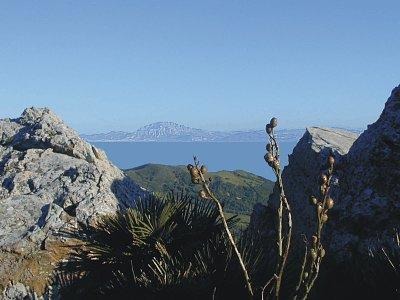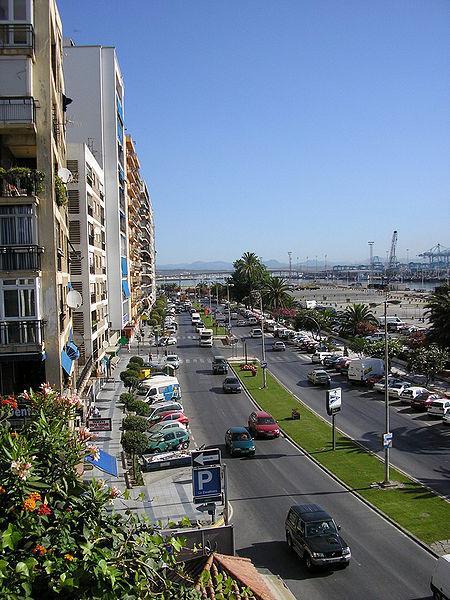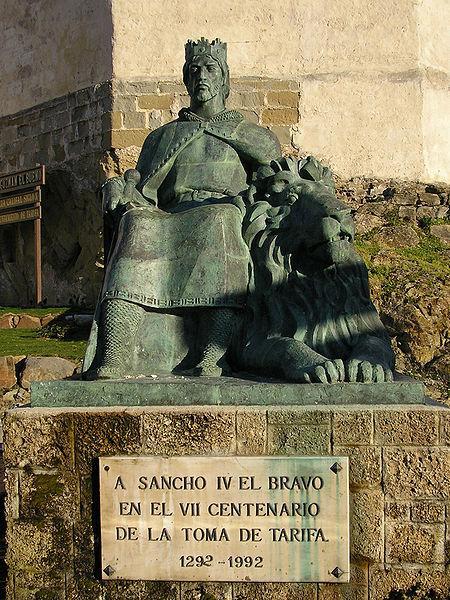Tarifa, Andaluzia, Spain
Suggest Place to Visit
5459
Track to location with GPS |
 |
Prehistory
Like the entire north of the Strait of Gibraltar, Tarifa is rich in rock art deposits that testify to the presence of cultures from the Paleolithic era. The set of caves and shelters existing from Tarifa to Medina-Sidonia correspond to a very wide period of time ranging from the Upper Paleolithic to the Bronze Age and which has come to be called Southern Art. Tarifa has around sixty of these shelters, among them the oldest in the region. The Cueva del Moro stands out from the Upper Paleolithic, with rock carvings representing horses and other elements of the local fauna.
Old age
Basilica of Baelo Claudia.
There are archaeological evidence of the presence of at least two Punic settlements of some importance within the municipality of Tarifa. The main site located is the one that contains a series of hypogean tombs located in 1987 on the Island of Las Palomas that suggest a Punic settlement under the current city of Tarifa. The second location would be located in Baelo Claudia or in its vicinity and although no archaeological remains have appeared, coins issued in this city with the double legend Bailo / BLN are known, the second place name of which is written in the Neo-Punic language.
Even the location of Punic structures in that city must be considered that the foundation of the Roman Baelo Claudia takes place in the 2nd century BC. This important city appears very early related to fishing and trade with North Africa, mainly with Tingis, present-day Tangier. In the middle of the 1st century, during the reign of Claudio Baelo Claudia acquired its greatest importance by granting it the rank of Roman municipality.
The extraordinary existing knowledge about the city of Baelo contrasts with the uncertainty about the location of a second city within the municipality of Tarifa. The Antonine Itinerary when describing the route between Malaka and Gades indicates that between the cities of Calpe Carteian (Carteya) and Belone Claudia (Baelo Claudia), perfectly located today, the cities of Porto Albo (Portus Albus) and Mellaria. On the other hand, the Anonymous of Ravenna, which describes the same route, indicates that between Cartetia (Carteya) and Belone (Baelo Claudia) were Traducta (Iulia Traducta), Cetraria (Caetaria) and Melaria.
According to these sources, four cities can be found on this stretch of coast, Portus Albus, Iulia Traducta, Caetaria and Mellaria. The one named Caetaria or Cetraria would correspond to an existing city in the current cove of Getares, whose current name seems to derive from Latin and whose archaeological remains have been located. It would therefore remain that the city of Mellaria would be located between Baelo and Getares and Iulia Traducta between this cove and Carteya. [25] Three locations have been proposed for the city of Mellaria, the mouth of the Río del Valle, the estuary of the Jara River and the current city of Tarifa, all of them located on a short stretch of coast, [26] and the last of which is the one that today is considered more probable in relation mainly to the urban continuity of the Punic deposits of the island and the later Visigoths. [27] Be that as it may, it is known that this city did not reach the title of municippum and its importance was eclipsed by the important nucleus of Baelo Claudia.
The progressive abandonment of Baelo Claudia takes place from the 4th century on, probably due to the fact that the city was seriously affected by an earthquake, although later both Baelo and Mellaria appear cited as a port of embarkation for the Vandals from Hispania to Africa. [28 ] Mellaria, on the other hand, seems to have been the settlement place of the Visigoths and probably Byzantines according to the discovery in the subsoil of the Castle of Los Guzmanes of several epigraphic inscriptions dating from the 7th century.
Middle Ages
In 710 Tarif Abu Zara, commander of Tarik, landed on the Island of Las Palomas and carried out an expedition along the northern coast of the Strait with the aim of checking the size of the military forces present. After verifying the absence of defense, he informed Tarik. A year later 9,000 men landed on the Rock of Gibraltar and undertook the conquest of the Iberian Peninsula. During its first centuries of existence, the newly founded Al-Yazirat Tarif was no more than a small fishing town. But from the 10th century the city began to be fortified, the Fatimids had reached North Africa threatening the Umayyad dynasty reigning in Al-Andalus. By order of Abderramán III a great fortress was built in the city, which was completed in 960.
Statue of Sancho IV, conqueror of Tarifa.
In the following centuries, Tarifa will depend first on the Taifa Kingdom of Algeciras in 1031 and later on that of Seville in 1057. From 1085 the troops of Castile commanded by Alfonso VI threatened the borders of Al-Mutamid's Kingdom of Seville. That is why the Sevillian had to ask Yusuf ibn Tasufin's Almoravids for help. After becoming strong in the cities of Algeciras and Tarifa, the Almoravids did not limit themselves to defending their allies, but began the conquest of Al-Andalus. Years later, in 1147, it was the Almoravids who, entering through the Strait of Gibraltar, would settle throughout the region until its decline after the battle of Las Navas de Tolosa in 1212. In 1231 Tarifa became dependent again on the Kingdom Taifa de Algeciras after the expulsion of the Almoravids from the area.
In 1273 the king of Granada asked the Benimerines of North Africa for help and gave them the cities of Tarifa and Algeciras. The Benimerines became strong in the city and began to defend the border with Castile. The strategic importance of the square led Sancho IV of Castilla to surround the city in 1292 and surrender it on September 21 of that same year. Tarifa was then in Castilian hands and its defense was entrusted to Alonso Pérez de Guzmán. The Benimerí threat is, however, constant and in 1294 it would be the North African troops with the help of the Portuguese troops who appeared in front of the walls of Tarifa and despite the harshness of the siege the city resisted. It happened in this siege that the Benimerines captured the son of Alonso Pérez de Guzmán and offered him to free him in exchange for the town. According to the chronicles of the time, the defender of Tarifa refused to surrender the city and offered his own knife to kill his son.
Tarifa is a Spanish municipality in the province of Cádiz, Andalusia. In 2008 it had 17,736 inhabitants. Its surface area is 419 km² and has a density of 42.26 inhabitants / km². Its geographical coordinates are 36º 01´ N, 5º 36´ W. It is located at an altitude of 7 meters and 101 kilometers from the provincial capital, Cádiz.
The municipality of Tarifa is located at the southern end of the Province of Cádiz, occupying the western part of the Campo de Gibraltar region.
Within its municipal term is the southernmost point of the Iberian Peninsula, the Punta de Tarifa or Marroquí, a geographical accident that is located on the Isla de las Palomas, today linked to the city itself by means of a road-street, which It serves as access to the lighthouse that is located there.
The Cape or Punta de Tarifa also serves as a dividing line for the waters of the Mediterranean Sea and the Atlantic Ocean, which intersect just in front of the city itself, which is therefore located in the narrowest part of the channel or Strait of Gibraltar, at a maximum distance of 14 kilometers from the Moroccan coast, which makes it the closest European city to the African continent.
Tarifa borders to the East with the municipalities of Algeciras and Los Barrios, to the North with the municipality of Medina Sidonia, and to the Northwest with those of Vejer de la Frontera and Barbate. The West, South and Southeast limits are not political-administrative but physical, so to the West it borders the Atlantic Ocean and to the South and Southeast with the Mediterranean Sea.
The historic center of the city of Tarifa, delimited by its old medieval walls, was declared an Asset of Cultural Interest in the category of Monumental Complex in 2003. [74] Wide sections of the old walled enclosure are preserved either in their original situation or integrated as part of the buildings, as is the case in the Alameda area. Of the three gates of the old medina, the Puerta del Retiro located to the east and the Puerta del Mar to the west have disappeared, but the so-called Puerta de Jerez that gave access from the north to the town remains. The Puerta de Jerez was built in the 13th century, probably at the time the city was under Benimerí control, when the walled enclosure was expanded towards the suburb. Nowadays, it has lost its character as a bent access due to the remodeling suffered, but its external structure remains practically unaltered. [75] To the south is the Castillo de Los Guzmanes. This fortress began to be built under the mandate of Abderramán III and its works concluded in 960, being modified on multiple occasions over the years. The so-called Torre de Guzmán el Bueno stands out within the group that forms the castle, which at the time protected the entrance to the city from the west. [76] Already within the city, various religious constructions are especially important. The Church of Santa María located next to the castle was a later rebuilt mosque. It is very simple in style with hardly any ornaments on the façade. [77] The Church of San Francisco was rebuilt on a pre-existing temple in 1797 and has a sober façade in the Baroque and Neoclassical style. [78] Finally the Church of San Mateo is the main temple of the city. It was built at the beginning of the 16th century in the Gothic style. In spite of the numerous buildings that today are attached to the sides of the temple, it is possible to observe the wide unfinished façade due to the withdrawal of the subsidies given by the Marquis of Tarifa during the lawsuit that was established with the city council. [ 79
Comments
We don´t have yet any comments about:
Tarifa (Cadiz)
Tarifa (Cadiz)
Be the first to leave a comment as it is very important to inform other people
Outros locais a visitar
Within a radius of 20 km from:Tarifa (Cadiz)
Naturpark der Estrecho |
| 4,7 Km |
 |
Algeciras Stadt |
| 15,7 Km |
 |
Hotel reservation near Tarifa (Cadiz) within a radius of 20 km
Why to book with TOURISTISCHE ROUTEN
The best prices
Our partnerships with the world´s largest operators offer research on the best market prices.
More options
At Rotas Turisticos you can book the hotel, buy the air ticket, book the transfer from the airport to the hotel and vice versa, book the local excursions, rent the car, take travel insurance and consult the places to visit and where to go.
Holiday Tips & Destinations
Hundreds of holiday destinations with all the options that allow you to easily choose the destination that best suits your dream vacation.
TOURISTISCHE ROUTEN
Links






